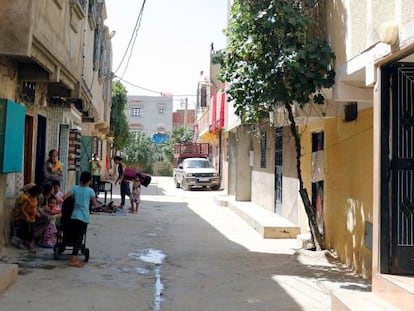Catalonia terror cell followed teachings of highly secretive Salafi sect
Takfir wal-Hijra allows for drinking of alcohol and eating of pork to disguise radicalization


The 12 young men who formed the terror cell that carried out last week’s terrorist attacks in Spain’s Catalonia region had been indoctrinated into the extreme Takfir Wal-Hijra (“excommunication and exodus”) sect of Salafi jihadism, counter-terrorism sources have told EL PAÍS.
The so-called takfiris comprise the most radical and violent strand of Salafi jihadism and figure in the European Union’s list of terrorist organizations. They also represent the most dangerous form of jihadism because their members hide in plain sight.
They represent the most dangerous form of jihadism because their members hide in plain sight
Evidence suggests Aldelbaky es Satty, the imam who headed the Catalonia terror cell based in the Catalan town of Ripoll – and who died in an accidental explosion in a house being used as a base of operations by the group – indoctrinated its members into this form of Salafi jihadism that is very difficult for security forces to detect.
The main defining characteristic of the takfiris is their willing to break the sacred rules of other jihadist groups in order to avoid being detected. They wear Western clothing, drink alcohol, take drugs, listen to music, watch television, go out with women and eat pork. In addition, they do not grow full beards or goatees.
In the case of the Catalonia terror cell, these “sins” for the jihad kept them off the radar of intelligence services. “This explains why neither the imam nor the 12 members of the cell ever showed any external signs of radicalization,” one police chief said.
“This conduct [on their part] makes our work and that of our informants in terms of identifying young people who are in danger of being radicalized very difficult,” one security service operative added.
The presence of the Takfir Wal-Hijra movement is not new in Spain. In 2007, Spain’s National Intelligence Center (CNI) noted the opening of six small mosques – four in Barcelona and two in Valencia – headed by takfiris. Their imams were Moroccans and Algerians with identical profiles and attitudes to the imam in Ripoll, a discrete figure who never spoke the word jihad from the pulpit or raised the suspicions of the faithful or locals in the small town of 10,000.
Neither the imam nor the 12 members of the cell ever showed any external signs of radicalization Police chief
A year later, a report from Spain’s police intelligence service (the CGI) dated April 19, 2008 warned of the presence of takfiris in Spain, analyzing a wave of suicide attacks in Algeria and Casablanca and highlighting increased social polarization as well as the radicalization of “a part” of the Muslim community.
“A heavily re-Islamized society and the globalization of the jihad have led to conditions where we are seeing a new threat from isolated territorial groups, or groups made up of young, so-called second-generation Islamists,” the confidential report states.
The authors of the report also noted that this crop of potential terrorists were takfiris as were several of the jihadists behind the Madrid train bombings in 2004 which killed 193 and left over 1,700 injured.
“Their willingness to commit criminal acts, the fact that they isolate themselves because they believe that they represent the only true form of Islam and their hatred, and rejection of all other Muslims, whom they consider corrupt or apostate, have seen them become a perfect breeding ground for young, uprooted Muslims in the West,” the report notes of the takfiris.
Abdelbaky es Satty was excellent at hiding his beliefs, making people think he was a humble man who preached peace
Abdelbaky es Satty was excellent at hiding his beliefs, making people think he was a humble man who preached peace. He had no previous convictions for terrorism crimes and raised no suspicions except when he traveled to Vilvoorde, one of the hot spots of jihadism in Belgium, in search for work in another mosque. He was turned down when he failed to provide details of his criminal record.
In fact, the imam had previously spent four years in prison on drug trafficking charges, the only error for the cleric who had followed the takfiri path.
The sect behind the assassination of Anwar Sadat
The Takfir Wal-Hijra sect could lay claim to at least eight mosques in Spain in 2009: five in Barcelona, two in Valencia and one in the North African exclave of Melilla. These are generally not ornate places of worship but low-key locations where the prime objective of secrecy is guaranteed. The imams are Moroccans and Algerians. The man behind the Twin Towers attack in New York, Mohamed Atta, and the main terrorists in the Madrid train bombings of 2004 were also takfiris, or adherents of the sect, according to their family, friends and police sources.
The movement was inspired by Shukri Mustafa, an agricultural engineer who founded the group in the 1960s as an offshoot of Egypt’s Muslim Brotherhood. Mustafa decreed the excommunication of “renegade” Muslims who did not share his radical ideas on Islam. He was executed in 1978 on suspicion of having ordered the assassination of Egyptian religious affairs minister Muhammad al-Dhahabi. After his death, his 5,000 or so followers were subject to persecution and fled the cities and took refuge in the countryside. Once there, they rejected modern life and attempted to return to rural ways. The assassination of Egyptian president Anwar Sadat in 1981 was carried out by takfiris. This and other attacks helped spread the movement’s ideas through Europe and Northern Africa.
English version by George Mills.
Tu suscripción se está usando en otro dispositivo
¿Quieres añadir otro usuario a tu suscripción?
Si continúas leyendo en este dispositivo, no se podrá leer en el otro.
FlechaTu suscripción se está usando en otro dispositivo y solo puedes acceder a EL PAÍS desde un dispositivo a la vez.
Si quieres compartir tu cuenta, cambia tu suscripción a la modalidad Premium, así podrás añadir otro usuario. Cada uno accederá con su propia cuenta de email, lo que os permitirá personalizar vuestra experiencia en EL PAÍS.
¿Tienes una suscripción de empresa? Accede aquí para contratar más cuentas.
En el caso de no saber quién está usando tu cuenta, te recomendamos cambiar tu contraseña aquí.
Si decides continuar compartiendo tu cuenta, este mensaje se mostrará en tu dispositivo y en el de la otra persona que está usando tu cuenta de forma indefinida, afectando a tu experiencia de lectura. Puedes consultar aquí los términos y condiciones de la suscripción digital.
More information
Archived In
Últimas noticias
Most viewed
- Alain Aspect, Nobel laureate in physics: ‘Einstein was so smart that he would have had to recognize quantum entanglement’
- David King, chemist: ‘There are scientists studying how to cool the planet; nobody should stop these experiments from happening’
- Maps of the US attack on Venezuela: Targets, airspace and deployed fleet
- Key points of the military attack on Venezuela: Early morning bombings and a ‘captured’ president
- Trump says Washington will control Venezuela until there is ‘a safe transition’










































